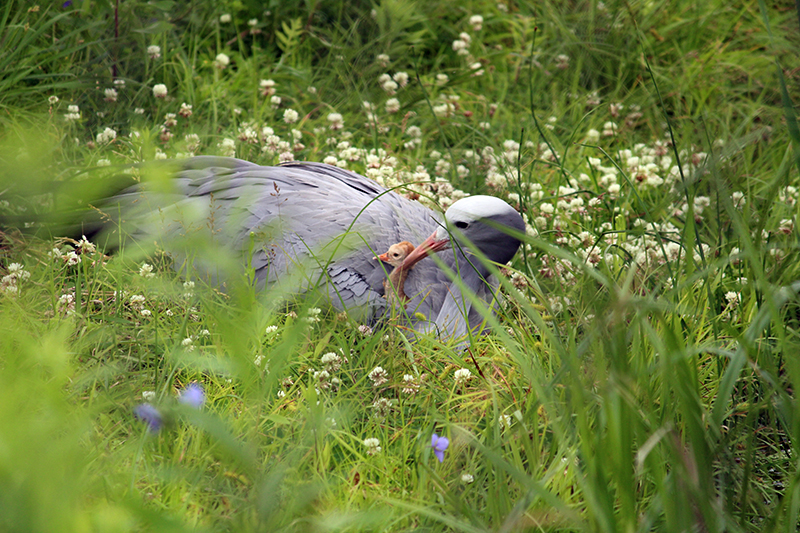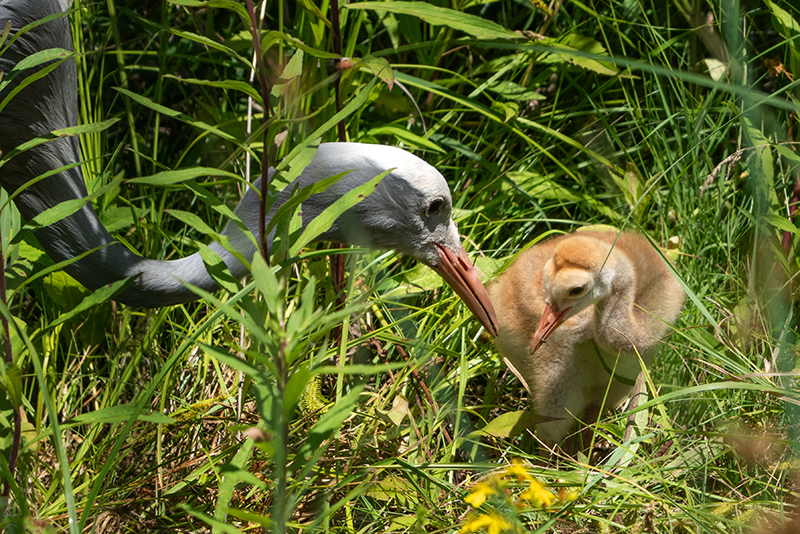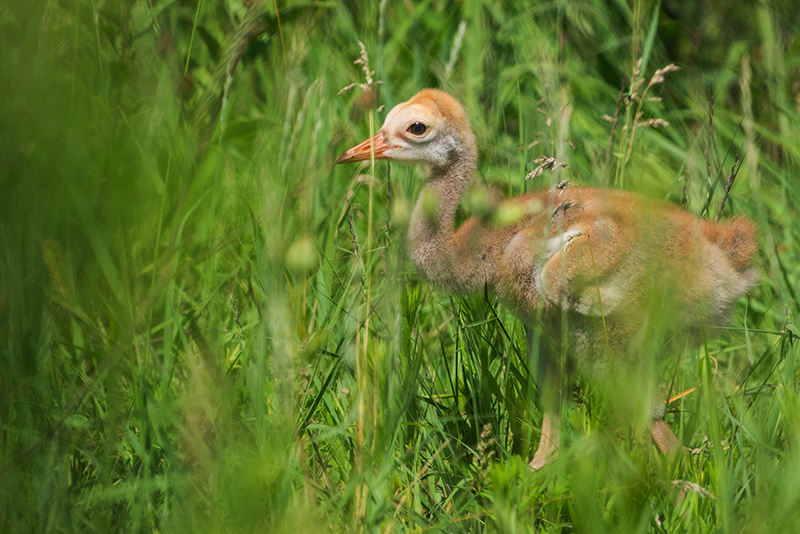
CONTACT: Ryan Michalesko, Communications & Advocacy Specialist, 608-356-9462 ext. 113
International Crane Foundation resident Blue Cranes cross-foster newly hatched Sandhill Crane chick
July 11, 2024 – Baraboo, Wis. – There’s a new crane in the marsh at the International Crane Foundation. Named Calypso, the chick was hatched on June 15 and paired with Blue Cranes Harold and Periwinkle for species cross-fostering. The new family will be on exhibit for a limited period this summer.
When Periwinkle and Harold were first introduced a couple of years ago, they quickly formed a very strong pair, but so far, they have not produced a fertile clutch of eggs. This gives a vulnerable species, native to southern Africa, the opportunity to learn how to be good parents before they have their own chicks.”
Cynthia Gitter, Assistant Curator of Birds at the International Crane Foundation
Of the world’s 15 crane species, 10 are endangered or vulnerable, including Blue Cranes, per the International Union for Conservation of Nature (IUCN) Red List of Threatened Species. There are estimated to be fewer than 30,000 Blue Cranes in the wild, and their population is decreasing.
“Since its inception, the International Crane Foundation has been focused on crane conservation in many facets,” Gitter said. “One of those efforts is to have cranes in human care that we can breed and call upon should those species need to be reintroduced into the wild.”
Blue Cranes face many of the threats common to cranes in the wild, including changes in agricultural practices, power line collisions, human disturbance, poisoning, land conversion, and illegal trade.

“If you come to see the family, you’ll get to witness many of the behaviors of crane families in the wild,” Gitter said. “You’ll see the Blue Cranes foraging and feeding the chick, protecting the chick from inclement weather, and teaching the chick skills, like how to avoid predators,” said Gitter, “but you’ll also see them having fun interacting as a family.”
Periwinkle and Harold quickly took to caring for the chick shortly after hatching. Though they will be together for a limited time, seeing a chick and family so up-close is rare.
“One behavioral trait about the chick is that it’s very good at hiding,” Gitter said. “It’s very good at watching mom and dad and learning the important skills needed to survive as a crane, which those who visit can see.”
Staff at the International Crane Foundation are also learning a lot from this experience.
“This allows us, specifically, to learn more about imprinting, which is how different species pick up on the behaviors and vocalizations of their parents,” said Gitter. “We’re learning more and more about how to best manage the offspring in our care.”
The ultimate goal, according to Gitter, is to have a species caring for its own species, but the practice of cross-fostering between similar species is a tried-and-true technique.
“There’s very little to no risk for the Blue Cranes nor the little chick,” said Gitter. “Our top priority is to ensure the health, safety, and well-being of all birds in our care, including this new family unit.”

Some visitors have already shared the excitement of the newly hatched chick, which stands at just a foot or so tall.
“I see the chick, I see the chick,” said Vida Derst, 5, as she perched on her tiptoes to get a glimpse. “This was our first time here, and we loved it,” said her grandmother, Mury Derst. “It’s such a gorgeous place to visit and well worth the drive. Right now, it’s so beautiful and peaceful with all the flowers in bloom, and of course, it was amazing to see the chick.”
Calypso will be paired with the Blue Cranes for a limited period this summer. Additionally, guided public tours of the Cranes of the World exhibit are offered three times daily. Those interested in seeing Calypso can find more information by visiting the Foundation here.
